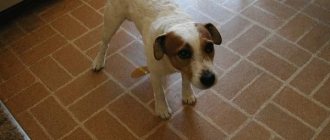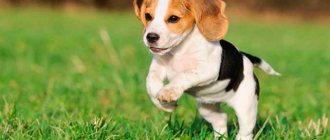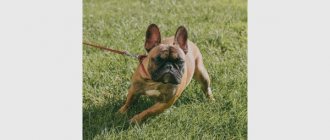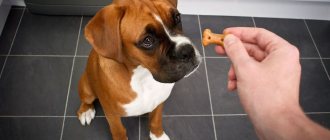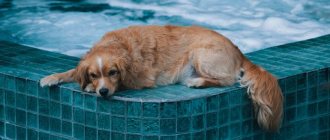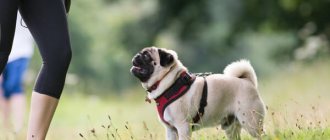How to train a puppy to go to the toilet outside is one of the most important questions that every owner must decide when getting a pet. Like many animals, the main “sanitary” rule for dogs is not to defecate where they sleep. Consequently, they have no need to go outside to the toilet, and if the owner wants to instill such behavior in his four-legged friend, it is important to train him correctly. Both very young and adult dogs have their own specific training requirements. Let's look at both options.
When should you start teaching your puppy to go to the toilet outside?
You can teach a puppy to use the toilet outside the home from the time when he can go for full walks and his body is sufficiently formed so that he can control himself in matters of toileting.
Until the pet has received its first vaccinations, it is worth going out with it, rather, in order to introduce it to the outside world. The puppy should be held in your arms and not allowed to interact with other animals or people. It is clear that it is impossible to teach a dog to go to the toilet on the street in such conditions.
The vaccination campaign ends with the third vaccination when the puppy is 3 months old. After quarantine, you can start walking - usually the dog is about 3.5 months old at this time. In addition, from about 4 months of age, puppies physiologically develop to the point of being able to endure leaving the house rather than making a toilet at the nearest point. An excellent age for teaching sanitary walks!
Basic rules of training
To ensure that your exercises with your pet have the desired effect, follow these recommendations:
- Be careful when choosing a place that will later be used as a toilet for the animal. Don't let him defecate behind garages, in trash cans, or landfills. There the puppy can pick up an infection or worms.
- Do not force your dog to relieve itself in an area where there are sharp objects; never place your pet in a puddle or on dirty snow.
- Remember that over time, the frequency of the urge to urinate and defecate should decrease in the animal. If this does not happen, contact your doctor. Your pet may have health problems. If everything is normal, gradually reduce the number of walks - an adult can tolerate 3-4 hours between trips to the toilet.
- Remember that a dog can be trained to defecate outside from the age of 4 months. Previously, you should ensure that she goes to the same place for diapering. This will make further studies easier.
- Do not accustom your animal to a tray with litter, even if you live in a private house. This intermediate stage will only be harmful. An exception can be made only by those owners who are forced to leave home often and for a long time, and cannot ask relatives or friends to take care of the pet. But they need to remember that in the future they will not be able to refuse the tray.
- Take the animal to the same place. The smell of urine and feces will remain on the grass, which will tell your pet that this is where he should go to the toilet.
- Use a leash and collar whenever you go out with your four-legged friend, even if you're traveling nearby. Remember, the dog can be distracted, frightened by loud noises, strangers, or other animals. The dog may get hit by a car or get into trouble with another puppy. Don't allow this to happen if you want to quickly instill toilet skills in your child.
- If your pet defecates at home, clean up after it immediately. Use specialized detergents that can be purchased at a pet store. Avoid chemicals that contain ammonia (the smell reminds your dog of urine) or chlorine (it irritates your puppy's respiratory tract).
- Be patient. Remember that a puppy at 3 months is not able to control his bowel movements. At this age, the animal has a fast metabolism, due to which it can go to the toilet quite often. Dogs older than six months can tolerate this before being walked.
- Before starting training, be sure to deworm the animal and give the animal basic vaccinations.
- Do not allow your puppy to go to the toilet at home. If you start taking him outside, do not make exceptions for him, otherwise the pet will not listen to you in the future. This also applies to night walks, which are necessary in the first months of a dog’s life.
- Take your pet outside immediately after waking up or 5-10 minutes after feeding. If your pet has recently eaten, do not engage in active play with it - such behavior can lead to volvulus. Limit yourself to a short walk.
Always clean up after your animal; there is no need to leave the fruits of its digestion on the street - it’s not nice.
Plus, you can earn a fine, which is provided for in the administrative code. If you have an emotional dog that defecates in joy at the sight of its owner about to walk it, prepare to go out discreetly. When the puppy grows up, teach him the “Sit” command - this skill allows the animal to control emotions.
Preparing for training
First, some tips for owners:
- Be patient. No matter how smart a dog is, it will take time for it to understand what you want from it and learn to tolerate it until the street. Be prepared in advance that the learning process may not be too fast;
- Make a feeding plan (preferably with your veterinarian). Determine the optimal portion size and how many feedings per day are needed. Give meals on a schedule and do not allow your dog to eat between scheduled meals. Puppies have very fast metabolisms, and the more often they eat, the more often you will need to go out;
- Prepare in advance a particularly tasty treat that you will use to reward your dog for doing things outside. Keep treats near the front door so you can quickly grab them when you go out with your puppy. Treats should be small (about the size of a fingernail). For each trip to the toilet - 3-5 pieces;
It is best to start training on vacation or at least on weekends - you should be at home all day and be able to take the puppy out many times. And once you start training, don’t quit halfway.
Mistakes when learning: what not to do
Special products are designed for cleaning heavily soiled carpets, upholstery of upholstered furniture made of all types of fabric, faux fur, and car upholstery.
You cannot hit or shout at the dog or poke your nose into puddles. Anger causes fear and anxiety, because of which force majeure will become more frequent, and walking will be perceived as punishment. Puddles and piles are immediately removed, soiled areas are treated with special detergents.
How to teach a puppy to go to the toilet outside
So, you have chosen the time when the puppy can go outside, you have the opportunity to devote the whole day (and probably even the night) to him. You made a feeding schedule and stuck to it. You can start training!
Your main task is to understand when your pet wants to go to the toilet, and when you notice the first signs, quickly put it on a leash and go outside. Usually dogs need this after sleep, meals, physical activity and active games. Your pet's behavior will tell you about the impending need - it can spin around, sniff, and squat. If you spend enough time with your dog, you will learn to recognize these signs.
When outside, find a quiet and peaceful place where your pet will not be distracted by anyone (neither other animals, nor people, nor toys). Often the owner himself switches attention: he pulls the leash, calls, starts playing or talking with the dog. Instead, you should just walk back and forth so that your pet is not distracted and can go to the toilet in peace. Be patient, even if a lot of time has passed and there is no result yet. When you notice that the dog has begun to do its business, quietly praise it, and when it finishes, reward it with a treat. Now you can play, take a walk, etc.
Such exits should be arranged every time the pet shows a desire to go to the toilet. Stick to the algorithm for at least a few days so that the puppy clearly understands what is required of him. If you have already started training, don’t be lazy and don’t let “one more time at home, it’s okay.” Such relaxations will not lead to effective results and will only prolong the overall training time.
As with feeding, it is also worth creating a schedule for sanitary trips. Usually this is 6-12 exits, depending on the pet’s age, training, and breed. Be sure to stick to your chosen schedule! At least a few days until the puppy gets used to it.
A detailed plan for toilet training a dog
Training a dog to toilet outside is a step-by-step process. Fortunately, most dogs try to have a designated place to relieve themselves and try not to shit in the places where they eat and sleep, so dogs learn well using a standard plan. First, make sure that you control your pet, that is, he is always in one of three positions:
- on the street where you are watching him;
- in an apartment/house under your supervision;
- in a confined, relatively small space, such as a cage, playpen or small room.
Depending on the situation, you must take certain actions. Let's consider each case separately.
You are walking your dog on the street.
While spending time together with your pet on the street, you keep an eye on him and, accordingly, know whether he has done his business before returning home. You can reward your dog for going to the toilet outside so that he understands that such actions on his part are correct.
Prepare treats for your pet in advance; they can be hidden in your jacket pocket, trousers pocket or bag. Make sure the treats are really good - to the dog's taste. Just as people would rather receive a piece of cake or a chocolate bar as a reward than broccoli, dogs have their own preferences. For many animals, pieces of low-fat cheese or meat are an excellent reward. Special dry, flavored treats are also very effective - by human standards, they can be compared to cookies. Regular dry food granules, which the dog already receives every day, may not be in great demand, like carrots for children.
Find a specific place around the house where you would like your dog to go to the toilet. If at first you bring the puppy to the same corner, then over time he will come running there himself. When you arrive at the chosen location, stop and wait until the dog begins to relieve itself. It should be fairly flat, but at the same time a secluded space.
The main thing is not to look at your pet closely while he sniffs the ground and “takes aim.” The animal may mistake your direct gaze for your desire to communicate or play, so it will not get down to business. If eye contact has already taken place, and the dog is interested in you, or the alluring smell from your pocket, just look somewhere to the side, crossing your arms over your chest. The pet will quickly lose interest in you and return to exploring the toilet area.
Wait until the puppy relieves itself. Once he's finished, praise him and give him the treat you had in store. While the dog is eating, you can stroke him, telling him that he’s doing well and calling him a good dog.
Positive food reinforcement is an important part of a dog's toilet training plan, but not all owners know about it. Many people give their pet a tasty reward when it has already emptied and runs back to them. But look at it from the puppy's point of view: in his mind, he received a reward for approaching his owner. The reward must be received immediately, which means that at first you will have to constantly be next to the dog on the street, without leaving its side. In some cases, it is the moment of giving out the treat that determines whether the puppy will become accustomed to using the toilet outside.
Kind words spoken with an enthusiastic intonation also make puppies very happy, but when you combine praise with food encouragement, they still learn faster. Some owners don't want to use treats, but it's a really effective tool, so why not use it? Judge for yourself: it’s one thing if at work they tell you: “You’re great, thank you!”, and quite another thing – “You’re great, thank you, keep your bonus!” Over time, when the puppy begins to consistently go outside to relieve itself, you will begin to give treats every other time, then even less often, and when the process becomes automatic, you will be able to refuse them.
The puppy is at home under supervision.
In an apartment or house you must constantly supervise the dog. To do this, you don’t need to look at your pet point-blank without taking your eyes away, otherwise he might get scared. It’s enough to glance at him with half an eye while going about your business, for example, making tea or listening to an audiobook. A puppy in a new home can be compared to a baby who has just learned to walk. It only takes a second for a child to disappear from sight. Likewise, a puppy, previously quiet and calm, can suddenly think about something of his own and run to make puddles. To make it easier to keep track of it, you can close the doors or place partitions in the openings, limiting the space for maneuvers to 1-2 rooms. If your dog is small or medium-sized, then you can fasten it to yourself by tying a leash around its waist, then it will not be able to sneak away while you are not looking.
If you do not look after your dog well, constantly missing the moment when it goes to the toilet, especially at the early stage of training to go outside, then training may be seriously delayed or completely useless. It is the owner's responsibility to take the dog out to relieve itself on time. Don't forget, initially the puppy does not realize that it matters a lot to people where he goes to the toilet.
The dog is left to its own devices in a cage or room.
In those moments when you are busy with your own affairs and cannot fully look after the puppy, you must leave it in a limited area. A playpen, cage or small room ready for testing by the dog is suitable for this. If the space is small, then the likelihood that the puppy will shit there will be less, since the baby will instinctively try not to dirty the area where he sleeps or eats. In addition, the limited space will not allow the dog to relieve itself in any other places in the apartment, which will avoid the development of bad habits, for example, shitting in the kitchen or marking in the hallway.
The presence of a dog crate causes conflicting feelings among owners, but it should be said that many puppies are comfortable sleeping in confined spaces that resemble a den if they are accustomed to this from childhood. It is advisable to place the cage in the bedroom so that at night the pet feels that you are next to him. If your ward is one of the dogs that cannot tolerate a crate, or you simply would not like to use it, then leave the puppy in a small room or kitchen, isolating his habitat with a partition. You can also use a playpen in which your pet will have a bowl of water, a bed and various toys. It is worth keeping in mind that the playpen is only suitable for small breeds of dogs, since medium and large animals can turn it over and get out.
Make sure in advance that in the area allocated for the dog there is a floor covering that is easy to clean, then the mistakes that occur at first in almost all puppies will not upset you too much. Whatever you use - a crate, playpen or bed - it should be cozy and comfortable for the dog, that is, it is too cold or hot, and the size allows the animal to sleep comfortably. Make sure that the dog is not near the window, because he may become overly interested in what is happening on the street and become overly worried, or, conversely, become frustrated.
In order for the puppy to get used to the crate and perceive it as his safe corner, and not as a trap and a form of punishment, proceed according to the following scheme.
Step 1. Stock up on treats and throw them inside the crate so that the puppy will come in and eat the bait. If he begins to suspect something and is afraid to come in, place a treat on the threshold. Gradually you will be able to throw pieces of food further and further. The dog should be free to enter and leave the crate whenever it wants. This way, climbing in will begin to be associated with play and reward. Do this exercise 3-5 times, repeat several times a day.
Step 2. As soon as the puppy gets comfortable and runs freely into the crate, wagging his tail, it’s time to close the door behind him. Start with 2-3 seconds. After a couple of days, put in a treat, close the door, then feed your pet through the bars and finally let him out of the cage.
Step 3: Now it's time to leave the puppy in the crate for a longer period of time. To do this, you can use a Kong-type toy. It is a ball with a hole for food. The dog will chew the toy and periodically take out pieces of food from it, which will definitely interest it more than the cage door. If Kong is not available, you can use other objects that your pet likes and usually distract him. When the puppy is busy playing or getting treats, go to another place for half a minute or a minute. Then open the crate door and call your puppy outside. If you practice this regularly, increasing the time intervals, the dog will learn to be calm in the crate.
To make it easier for the puppy to get used to the sleeping place, you can put a towel there, on which he slept at the breeder with his mother, brothers and sisters, or put your own T-shirt. As a last resort, a small soft blanket or fluffy toy will do.
It is advisable to place your pet in a crate when you see that he is starting to fall asleep, then it will be easier to develop the habit of sleeping in a certain place. Usually dogs want to sleep after they have run around and played enough. They nod off or lie down on the floor as if an internal switch has gone off. If you missed the moment and the baby managed to fall asleep somewhere in the apartment, carefully pick him up in your arms and put him on a sleeping place. Do this as quietly as you can.
Now you can use the crate both at night and during the day - in those moments when you cannot look after the dog at home and do not walk with it on the street. As for the location of the cage, it is preferable that it be in your bedroom. At night, your pet will feel your presence nearby, smell you, hear your breathing, which will calm him down. The puppy may have never spent the night alone with the breeder, so your proximity will make adaptation faster. During the day, the cage can be moved to another part of the apartment, if it is more convenient. The only thing is that it is undesirable to place it on the aisle, where the dog can often be disturbed by household members passing back and forth.
What to do if the puppy relieves itself in the crate? Don’t worry, clean up so that there is no unpleasant smell left and analyze what caused the failure. Was the dog locked up too long? Did she go to the toilet before you put her in the crate? Maybe her diet or drinking regimen has changed? Do you walk your puppy often enough? Are there medical problems that prevent you from maintaining sufficient time intervals?
Even if you don’t understand why the confusion occurred, don’t be upset. Failures happen to everyone. Any dog can make mistakes several times during the training process. If the situation looks like the puppy is specifically relieving himself in the crate, move him to another fenced area or small room.
There are animals that accept the sleeping place prepared for them immediately, while others are capricious or afraid when their owners are about to put them to bed. This is worth dwelling on in more detail, since it is extremely important to distinguish whether the puppy is whining or barking because he knows that in this way he will get out of the crate, or he is signaling that it is time for him to go outside, and his needs cannot be ignored. Most often, you can ignore the puppy's dissatisfaction when you have just put him in a crate, and he has recently relieved himself. Many pets go to bed within a few minutes and immediately fall asleep. But if a quiet and well-balanced baby suddenly starts whining in the middle of the night, get up and take him outside to find out if he needs to go to the toilet. See how he behaves on subsequent nights. If you understand that the puppy does not need to relieve himself, and he wakes you up only to play, then ignore his calls in the future. If he gets into the habit of going to the toilet at night, then wait more and more time each time before going out with him. It is especially worth listening to dogs that start crying at 5-6 in the morning - the likelihood that they need to go to the toilet is highest. Try to let your pet out of the cage at the moment when he calms down and does not bark, so that the dog does not think that he can achieve what he wants just by raising his voice. Wait for a pause or make some kind of harmless sound yourself that will confuse your pet and make you quiet down, with your ears pricked up.
Puppies usually love their crates and get used to them quickly. This place can be compared to a person's bedroom. But there are also individuals for whom this option is not suitable. When they get into a cage, they breathe heavily, drool, bark angrily and do not calm down. These puppies will do better staying in a small room. After all, they didn't read the article about how they should love lair-like spaces. But this category of pets is in the minority, so don’t give up crate training your dog if it’s just fussing around there for a couple of minutes. You need to take the puppy outside immediately after opening the cage - otherwise why did he endure it?
Gradually expand your dog's freedom of movement around the house. Spend time with your pet in different rooms, leaving your scent in them, train them there, or just play.
Other situations
They simply don't exist! In the process of learning to go outside to relieve yourself, the puppy should always be in one of 3 positions: with you on a walk, under supervision at home, or alone in a limited safe space.
Don't make exceptions. If you don't make mistakes, toilet training will be effective and won't take much time. Literally a month of effort - and you will get a comfortable life with a clean dog.
How to stop going to the toilet at home
An important part of training is to get the dog to stop using your home for sanitary purposes. The following tips will help:
- Lock your puppy in a crate at night and while you are away. As already mentioned, the animal does not go about business where it sleeps. Accordingly, locking him in a limited space, in fact, you leave him no choice but to endure. However, the cage should under no circumstances be an alternative to learning! Don't put your dog there too often or for too long. Your puppy needs you, your care and physical activity. If, while in a crate at night, the dog begins to howl, take it outside. Although this behavior may also mean that the pet simply needed your attention.
- Carefully clean areas already “marked” by the puppy, using appropriate products from pet stores. Unlike ordinary detergents, specialized ones will completely remove the odor. Animals tend to return to the place where they have already arranged a toilet for themselves, so do not give your pet unnecessary temptations.
If possible, it is better to remove carpets for a while, as it is very difficult to remove odors from them.
- If you find excrement in the house, do not throw it away immediately - take it with you to the sanitary exit, put it in the right place and bring the dog to smell it. This will help her go to the toilet outside.
- If you catch your puppy doing things around the house, don't yell at him. Instead, gently interrupt, you can say “No, no!”, clap your hands. After that, put on a leash and go outside. Don't forget to reward your pet when he finishes what he started.
The popular method of “poking” pets with their muzzles is their “mistakes”. This is a completely wrong approach and will not lead to the desired results. Also, you should not punish puppies if they were not patient or made a mistake, for example, during the game. Like children, they still have little bladder control (dogs begin to do this at 4-6 months). If you punish for “incidents,” the puppy understands that you are unhappy, but will not be able to change its physiology. Therefore, there is a high chance that he will simply begin to be afraid of you and choose more secluded corners for sanitary purposes.
Punishment for misbehavior
Toilet training a dog is not at all difficult. When your pet has learned that if he does his business outside, this is good and the owner is very happy, you should begin to teach him that such behavior at home is no longer acceptable. On average, this process takes 2-2.5 weeks.
To do this, it is enough to react with the prohibiting command “Fu” every time the puppy is caught at the “scene of the crime.” The team should always be the same. The intonation with which you pronounce this command is very important. Don't scare your pet, don't shout. Speak calmly, loudly and clearly.
In general, as practice shows, there may be two prohibitive commands for your dog: “Ugh” or “No”. Moreover, if the “Fu” command should mean a categorical prohibition, then the “No” command may mean that such behavior is not permitted in this particular place, but is permissible in other cases. Read about how to teach your dog basic commands yourself.
Common problems and their solutions
No. 1. Puppy keeps peeing at home or defecating in crate
- If training does not bear fruit, most likely you are not training your pet hard enough, you have set the schedule incorrectly, and you cannot catch the moment when you need to go out. Adjust basic aspects of training and consult your veterinarian if necessary.
- If the puppy is toileting in the crate, it is likely too large and the dog has the opportunity to create a “bedroom” and a “sanitary area” for himself. The optimal size is such that the animal can lie, stand and sit freely. If the area has nothing to do with it, it’s worth going to see a veterinarian. Perhaps the puppy was previously crated for too long and had no choice but to misuse the space provided. This behavior requires correction, but it can be difficult to do this without a specialist. In addition, the desire to roll in one's own excrement and other atypical habits may be associated with certain diseases.
No. 2. You can't catch the moment when you have to go outside
- Stay close to your puppy at all times. Temporarily limit his movement around the apartment so that he is in the same room with you - close the doors, place special gates in the openings.
- If you still can't, use a cage. But in moderation!
No. 3. The puppy does not want to pee outside; he walks and plays instead of satisfying sanitary needs
- Some owners o. Wait at least 10 minutes and do not distract the puppy with anything. If nothing happens, return home and try again in another 10-15 minutes. Sometimes a third try is required.
- Check that the leash is 2 m long.
- Often the puppy does not go to the toilet because the owner distracts him - he switches the animal’s attention to himself. To avoid getting in the way, just wander back and forth. Don't talk to the dog or try to play.
- Make sure your four-legged friend has no other distractions - toys, other dogs.
Different situations - different approaches
To choose the right learning method, you need to consider several factors:
- Age : puppy or adult animal;
- Where did you get the dog : bought a puppy, adopted an adult dog from other owners, or picked up an animal from the street;
- Education : knowledge of basic commands (“Come to me”, “Fu”, “Lie down”, “Sit”);
- Temperament characteristics : calm or impulsive animal.
Age is a key factor. It is easier for a puppy to learn because it has not yet developed a stable behavior pattern. An adult dog, like an adult human, tends to act out of habit. This habit is not easy to “break”: it takes a lot of time and effort.
The second factor is no less important. The puppy does not yet divide his behavior into right and wrong - it’s time to teach him how to do this. It is much more difficult with an adult dog who has lived in a kennel and stray animals - they need to prove that they cannot go to the toilet whenever and wherever.
Other factors indicate the complexity and duration of training. Of course, it will be easier if the dog already knows how to do something and behaves quite calmly. If this is not the case, you will have to look for methods of pacification and additional motivation for the dog (for example, not only a treat, but also a game).
How to train an adult dog
To teach an adult dog to go to the toilet outside, follow these tips:
- If she previously lived in a house and not in a booth, her “mistakes” are most likely associated with stress from moving to you , from a new environment, etc. In this case, you can lightly scold your pet for “mistakes”, but do not punish him. In general, your task is to help him adapt. The sooner this happens, the sooner the behavior will return to normal.
- If the dog previously lived in a kennel, he is not accustomed to the fact that he cannot have a toilet in any place convenient for him and must wait until he goes outside. In this case, the pet will actually have to be trained from scratch. The technique is generally the same as in the case of puppies, but there are two important features. On the one hand, adult animals do not need to be taken out so often - usually 3-4 times are enough for them. On the other hand, training them is not as easy as puppies because they already have established habits and behaviors. You may need professional help to change them.
If enough time has passed since the move and you are unable to train your pet, this is a reason to see a veterinarian. Also, you should not ignore the visit if the dog suddenly changed its behavior and, having seemingly learned to walk outside, began to make sanitary stops in the house again. And if you have a male dog who is marking his territory, consider neutering.
Alternative Methods
An excellent option would be if at the very beginning of the dog’s stay in the new home, you will also be there permanently. For example, it is better to get a dog during the holidays and devote a lot of time to training it. But this is not always possible.
Therefore, you need to start disciplining the animal by accustoming it to a place for the toilet in the house. For these purposes, you can use a tray or disposable diapers.
In addition, many owners prefer not to walk dogs of decorative breeds (in winter, in dirty weather), so this method of training will be very useful.
To accustom an animal to a tray or diaper you need:
- Each time after feeding, take or take the animal to the designated place;
- The diaper should be placed in the place where puddles usually remain;
- Before you begin training, you need to remove all places where the animal has previously marked. It is necessary to remove the smell using special means so that it no longer attracts;
- For dogs, you don’t need to add special litter; you can add a piece of newspaper to attract them. It can be left for the training period so that the dog can smell it;
- Don't forget to praise your pet if he succeeds.
Remember that you cannot train your dog to relieve itself in a diaper very quickly. But this will greatly help in further training to use an outdoor toilet.
